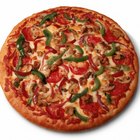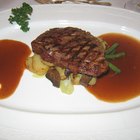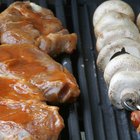humonia/iStock/GettyImages
In a utopian pizza-making world, every backyard would have a brick oven. Fire bricks have been used to build the cooking chambers of wood-fired ovens for centuries. Fire bricks provide the consistent high heat required to blister pizza dough perfectly, and their non-porous surfaces are perfectly safe to cook on. Even if your backyard isn't graced with a brick oven, you can replicate the result with a few fire bricks and a good grill.
The Original Oven
Baking dough-based products, from bread to pizza, in a wood-fired oven has long been acknowledged superior to other baking methods for good reason. The results of baking in a wood-fired oven have less to do with the wood and more to do with the heating properties of the oven itself. The baking chamber is formed of fire bricks, dense clay bricks capable of absorbing and redistributing intense levels of heat. Fire bricks are so dense they are nearly completely non-porous, creating a food-safe surface and a natural steaming effect even the best stainless steel ovens can't replicate.
Perfect Pie Crust
Fire bricks can absorb an immense amount of heat from any heat source. When the heat is contained in a baking chamber, the temperature will continue to climb well beyond that of the original heat source. Ovens used by Neapolitan pizza makers -- pizzaiolos -- average between 900 and 1,100 degrees Fahrenheit. Pizza baked at these temperatures will cook in less than three minutes, resulting in a blistered crust that folds easily. Moisture is quickly drawn from the dough during baking and deflected around the cooking chamber, creating perfect crust with ideally cooked toppings.
Portable Pizzaiolo
Creating a makeshift pizza oven is simple if you have a few fire bricks and an outdoor grill. While your grill will not reach the temperatures of a Neapolitan pizza oven, it will become extremely hot and should be treated cautiously. The grill itself should be sturdily constructed stainless steel and it should be solidly placed, ideally on a stone patio or somewhere else where it won't create a fire hazard. Using charcoal imparts a lovely, smoky flavor to the crust akin to that of a wood-fired oven, but propane heats the bricks faster and is easier to control.
Preparing the Bricks
Fire bricks are non-porous enough that they require little cleaning. Use a clean, stiff-bristled brush to remove any particles from the bricks before cooking. While fire bricks can withstand nearly limitless heat, they cannot stand water. Do not use any liquid on the bricks. Water is unnecessary and may affect the bricks' integrity and cause them to crack when heated. Once your bricks are ready and your grill is situated, place the fire bricks directly on the grates. Cover the grill and heat the fire bricks over medium-high heat for at least one hour.
The Fun Part
Putting bricks on a grill will heat them to the ideal pizza-making temperature of between 500 and 550 F. Be prepared with a sizable cutting board and platters waiting to receive your finished pizzas. They will cook quickly, in no more than six minutes. Sprinkle the fire bricks with a small handful of cornmeal and cook the pizzas directly on the bricks with the grill's cover closed. Check their progress often. When you've finished cooking, turn off the heat and leave the grill uncovered overnight until the bricks have cooled completely.
Related Articles

How to Grill With a Pizza Stone and ...
How to Cook Food in a Clay Oven

How Long to Bake a Pizza With Lots of ...

How to Make Fabulous Pizza on a Gas ...

About Cooking Stones

How to Use a Weber Gas Grill: First ...

How to Build Your Own Mobile Kitchens
Convection Broiling Vs. Convection ...

Does Heat Transfer Evenly Through ...

How to Use a Smoker Box for Gas Grilling

Directions for Cooking Frozen ...

How to Make Your Pizza Crust Crispy

Difference Between Baking on the Top & ...

How to Clean a Pizza Stone

Example of Passive Solar Energy

Is Revere Ware Aluminum?

How to Cook With a Gas Fireplace

Uses of Macadamia Nut Shells
How to Keep Waffles Hot at a Brunch

How Long and at What Temperature Do You ...
References
- On Food and Cooking: The Science and Lore of the Kitchen; Harold McGee
- A16: Food and Wine; Nate Appleman
- Build Your Own Wood-Fired Oven; Alan Watt
Resources
Writer Bio
Dominic Miller is a sommelier and restaurateur with more than 20 years of experience in the hospitality industry, during which he has served as a consultant to several of America's most iconic restaurants and wineries. He received a Bachelor of Arts from Goddard College, where he studied economics and creative writing, and holds additional degrees in hospitality management and culinary arts.